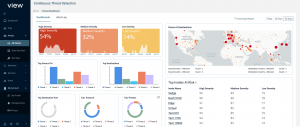With the macro-trends of climate change and remote work, there is increasing pressure to make buildings “smart” to save cost, improve sustainability, and make better employee experiences. Owners and operators are embracing IoT and AI to improve their buildings, but this is also opening them up to cybersecurity risk. Fortunately, emerging cloud-based technologies make it easier to create a comprehensive system to analyze, monitor and control security centrally. This article will introduce three smart building cybersecurity solutions, namely, Secure Access Service Edge (SASE), Security Information and Event Management (SIEM), and Continuous Threat Detection (CTD), and how they can help owners and operators keep their buildings safe while making them smart.
Before diving into these solutions, it’s crucial to understand the difference between OT and IT. While Information Technology (IT) refers to the use of computers and software for processing and securing information, OT is associated with the hardware and software used to change physical state of devices, such as industrial control systems in smart buildings. OT environments prioritize availability and safety over confidentiality, unlike IT systems where data security is paramount. This difference in priority and the real-world impact of OT systems bring about unique security challenges.
Secure Access Service Edge (SASE)
SASE is a cybersecurity framework that combines network security and wide area networking (WAN) capabilities in a single cloud-based service, such as View’s Secure Edge. In simple terms, SASE ensures that only authorized users can access specific resources, whether they’re on-site or remote, thereby adding an extra layer of security to smart buildings. Unlike a traditional Virtual Private Network (VPN), which primarily focuses on providing a secure tunnel for remote access, SASE moves beyond this by integrating comprehensive networking and security functions into a single service, offering not only secure connectivity but also a granular access management system to prevent users from moving laterally within the network and gaining access to devices outside of their intended scope.
In OT environments, like smart buildings, systems are in operation 24/7. The real-time data these systems generate is crucial for optimization functioning. SASE not only provides secure access to users, it also provides a secure tunnel for data, which securely enables cloud-based applications and accelerates the digitalization of buildings.
Continuous Threat Detection (CTD)
CTD is a security solution that provides real-time monitoring and threat detection in OT environments. It continuously analyzes network behavior, identifying anomalies that could indicate potential threats, making it particularly relevant to the ever-active networks of smart buildings.
In the context of smart buildings, CTD plays a pivotal role in safeguarding the myriad OT systems by detecting malicious activities or common vulnerabilities and exposures (CVEs) before they can be exploited. Its continuous monitoring approach ensures that potential threats are identified promptly, reducing the window of opportunity for threat actors and minimizing potential damage.

Security Information and Event Management (SIEM)
SIEM is a combination of two technologies: security information management (SIM) and security event management (SEM). SIEMs like Splunk or QRadar collect and analyze data from various sources within a network to identify unusual activities or patterns that might indicate a security breach.
The incorporation of SIEM in smart building environments can enhance security by providing a holistic view of the entire network, including OT systems. It aggregates log data from various sources like security controls, network appliances, and system software, thereby helping in early detection of threats. Additionally, SIEM can aid in compliance with regulatory standards, a growing concern in the OT landscape.
Conclusion
The transition from conventional buildings to smart buildings, while exciting, brings unique security challenges. The OT systems that control these advanced structures necessitate a different security approach than traditional IT systems. However, by adopting cloud-based tools like SASE, CTD, and SIEM owners and operators can create a modern security apparatus to protect their buildings: SASE provides a single point to control access, CTD provides continuous monitoring and analysis about activity, and all the data on activities, vulnerabilities and events can feed from SASE and CTD to a SIEM to provide centralized visibility. The three platforms working together to give you centralized control, monitoring and visibility.